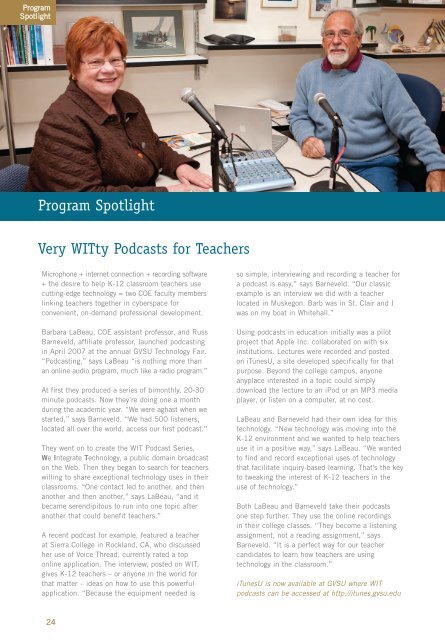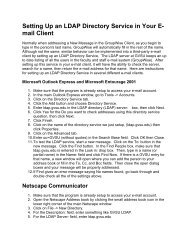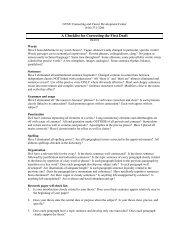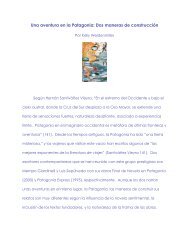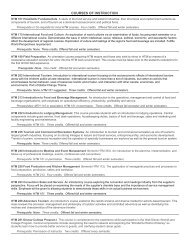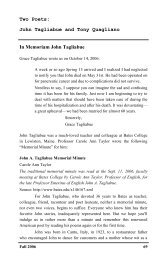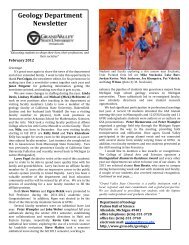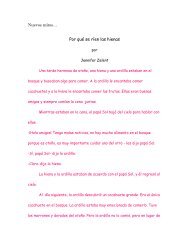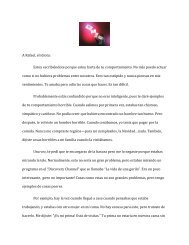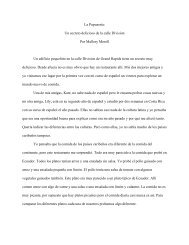2008-2009 - Grand Valley State University
2008-2009 - Grand Valley State University
2008-2009 - Grand Valley State University
You also want an ePaper? Increase the reach of your titles
YUMPU automatically turns print PDFs into web optimized ePapers that Google loves.
Program<br />
Spotlight<br />
Program Spotlight<br />
Very WITty Podcasts for Teachers<br />
Microphone + internet connection + recording software<br />
+ the desire to help K-12 classroom teachers use<br />
cutting-edge technology = two COE faculty members<br />
linking teachers together in cyberspace for<br />
convenient, on-demand professional development.<br />
Barbara LaBeau, COE assistant professor, and Russ<br />
Barneveld, affiliate professor, launched podcasting<br />
in April 2007 at the annual GVSU Technology Fair.<br />
“Podcasting,” says LaBeau “is nothing more than<br />
an online audio program, much like a radio program.”<br />
At first they produced a series of bimonthly, 20-30<br />
minute podcasts. Now they’re doing one a month<br />
during the academic year. “We were aghast when we<br />
started,” says Barneveld. “We had 500 listeners,<br />
located all over the world, access our first podcast.”<br />
They went on to create the WIT Podcast Series,<br />
We Integrate Technology, a public domain broadcast<br />
on the Web. Then they began to search for teachers<br />
willing to share exceptional technology uses in their<br />
classrooms. “One contact led to another, and then<br />
another and then another,” says LaBeau, “and it<br />
became serendipitous to run into one topic after<br />
another that could benefit teachers.”<br />
A recent podcast for example, featured a teacher<br />
at Sierra College in Rockland, CA, who discussed<br />
her use of Voice Thread, currently rated a top<br />
online application. The interview, posted on WIT,<br />
gives K-12 teachers – or anyone in the world for<br />
that matter – ideas on how to use this powerful<br />
application. “Because the equipment needed is<br />
24<br />
so simple, interviewing and recording a teacher for<br />
a podcast is easy,” says Barneveld. “Our classic<br />
example is an interview we did with a teacher<br />
located in Muskegon. Barb was in St. Clair and I<br />
was on my boat in Whitehall.”<br />
Using podcasts in education initially was a pilot<br />
project that Apple Inc. collaborated on with six<br />
institutions. Lectures were recorded and posted<br />
on iTunesU, a site developed specifically for that<br />
purpose. Beyond the college campus, anyone<br />
anyplace interested in a topic could simply<br />
download the lecture to an iPod or an MP3 media<br />
player, or listen on a computer, at no cost.<br />
LaBeau and Barneveld had their own idea for this<br />
technology. “New technology was moving into the<br />
K-12 environment and we wanted to help teachers<br />
use it in a positive way,” says LaBeau. “We wanted<br />
to find and record exceptional uses of technology<br />
that facilitate inquiry-based learning. That’s the key<br />
to tweaking the interest of K-12 teachers in the<br />
use of technology.”<br />
Both LaBeau and Barneveld take their podcasts<br />
one step further. They use the online recordings<br />
in their college classes. “They become a listening<br />
assignment, not a reading assignment,” says<br />
Barneveld. “It is a perfect way for our teacher<br />
candidates to learn how teachers are using<br />
technology in the classroom.”<br />
iTunesU is now available at GVSU where WIT<br />
podcasts can be accessed at http://itunes.gvsu.edu


